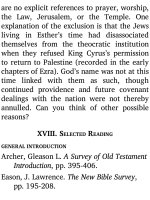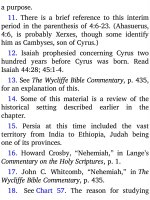Jensens survey of the old testament adam 257
Bạn đang xem bản rút gọn của tài liệu. Xem và tải ngay bản đầy đủ của tài liệu tại đây (191.06 KB, 4 trang )
c) Study the four outlines which divide the
book into two main sections.
d) How is Judah brought into the book?
e) Add to the list of key words.
f) Read the key verses in the Bible text. How
do they represent the main theme of the
book?
III. APPLICATIONS
1. What does the book of Nahum teach
about God?
2. What place does righteous wrath have
in the life of a Christian? What are your
reactions to these comments:
Surely there is a place for a book like
Nahum even in the revelation of Grace.
Instead of taking the Book of Nahum
out of the Bible, we had better leave it
there. We need it. It reminds us that
love degenerates into a vague di usion
of kindly feeling unless it is balanced
by the capacity of a righteous
indignation. A man who is deeply and
truly religious is always a man of
wrath. Because he loves God and his
fellow men, he hates and despises
inhumanity, cruelty and wickedness.
Every good man sometimes prophesies
like Nahum.17
3. How may the Gospel be likened to news
about the downfall of one’s enemy? (Cf. Nah
1:15 and Rom 10:15.)
IV. SELECTED READING
GENERAL INTRODUCTION
Eiselen, F. C. “Nahum.” In The International
Standard Bible Encyclopedia, 4:2109-11.
Ellison, H. L. The Old Testament Prophets, pp.
70-72.
Freeman, Hobart E. An Introduction to the Old
Testament Prophets, pp. 225-31.
Smith, George Adam. The Book of the Twelve
Prophets, 2:77’-113.
COMMENTARIES
Ellicott, Charles J., ed. Commentary on the
Whole Bible, vol. 5.
Feinberg, Charles L. “Nahum.” In The
Wycliffe Bible Commentary.
Fraser, A. “Nahum.” In The New Bible
Commentary.
Maier, Walter A. The Book of Nahum, a
Commentary.
ZEPHANIAH: DAY OF DESOLATION AND









